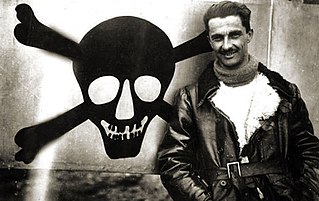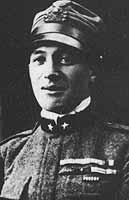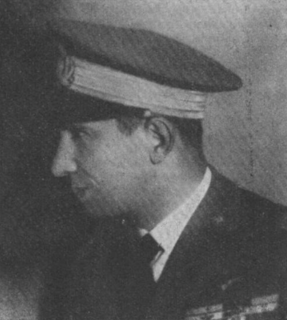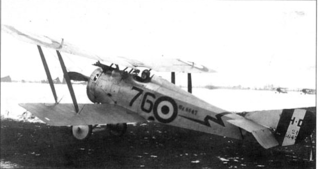Related Research Articles

Count Francesco Baracca was Italy's top fighter ace of World War I. He was credited with 34 aerial victories. The emblem he wore side by side on his plane of a black horse prancing on its two rear hooves inspired Enzo Ferrari to use it on his racing car and later in his automotive company.

Fulco VIII, Prince Ruffo di Calabria, 6th Duke of Guardia Lombarda was an Italian World War I flying ace and senator of the Kingdom from 1934 until his death. He was also posthumous father-in-law of King Albert II of the Belgians, and grandfather of King Philippe of Belgium.

LieutenantFlavio Torello Baracchini was an Italian World War I fighter ace credited with 21 confirmed and nine unconfirmed aerial victories. His confirmed victory total ranked him fourth among Italian aces of the war.

Maggiore Sebastiano Bedendo was a World War I flying ace credited with five aerial victories. After completing his education postwar, he rejoined Italian military aviation. He set several world aviation flying records with a Nuvoli N.5 monoplane before dying in an air crash.
CapitanoGuido Masiero was a World War I flying ace credited with five confirmed and ten unconfirmed aerial victories. He was a prewar lancer who used his civilian engineering expertise to wrangle a transfer to aviation duty.

Amedeo Mecozzi was an Italian fighter ace of World War I, a general of the Italian Regia Aeronautica and a military theorist credited as the founding father of the "Attack air force" doctrine, which made him a strong opponent to general Giulio Douhet's theories.
Sergente MaggioreAntonio Chiri was a World War I flying ace credited with six confirmed and seven unconfirmed aerial victories.
Tenente Luigi Olivi was an Italian World War I flying ace credited with six aerial victories. He won two awards of the Silver Medal for Military Valor and was killed in action.
Sergente Cosimo Rizzotto was a World War I flying ace credited with six aerial victories.
TenenteLeopoldo Eleuteri was a World War I flying ace credited with seven aerial victories.

TenenteMario Fucini was a World War I flying ace who claimed credit for 13 aerial victories during the war; seven of these were confirmed in 1919.
Antonio Riva was an Italian pilot and a World War I flying ace, credited with seven confirmed and seven unconfirmed aerial victories. In 1951, he was executed by firing squad under the newly established People's Republic of China for allegedly conspiring to assassinate Mao Zedong and other Communist leaders.
TenenteLuigi Olivari was a World War I flying ace who claimed 19 aerial victories. His Spad VII stalled into a fatal crash on 13 October 1917. Posthumously, he was awarded credit for eight aerial victories.
TenenteCarlo Francesco Lombardi known as Francis was a World War I flying ace credited with eight aerial victories. Postwar, he was active in his family's rice refinery, as well as in record breaking flights. He formed the AVIA aviation company in 1938.

Tenente colonnelloAlvaro Leonardi was a World War I Sottotenente from Italy and a flying ace credited with eight aerial victories.

Brigadier General Ferruccio Ranza began his military career as a World War I flying ace credited with seventeen confirmed victories and eight unconfirmed ones. Postwar, he rose to command of several area commands of the resurgent Italian air force. He served through the end of World War II.
PraporshikGrigoriy Suk was a flying ace for the Imperial Russian Air Service during World War I.
Generale di Brigata AereaMarziale Cerutti began his military career in Field Artillery, but became a flying ace after his transfer to aviation service. He would be extensively decorated for valor, and credited with 17 confirmed aerial victories. He would also remain in Italy's aviation branch after World War I, becoming an officer of increasing importance. He rose through the ranks between the World Wars to become a Wing Commander with the rank of colonnello. During World War II, he served as Chief of Staff in Italy's North African Headquarters before being placed in command of Italy's air transport command. When Italy declared its armistice on 9 September 1943, Cerutti chose to continue service to Benito Mussolini. This resulted in his suspension from military duties at the end of World War II. He died in a motorcycle accident on 26 May 1946 while awaiting a final determination of his military status.
CapitanoErnesto Cabruna (1889–1960) was a professional soldier who became a World War I flying ace credited with eight aerial victories. He served in Italy's military police, beginning in 1907. After service in Libya and Rhodes, he received a Bronze Medal for Military Valor a year after Italy's involvement in World War I began. He turned to aviation, became a pilot, and as such earned his first Silver Medal for Military Valor at the end of 1917.
79a Squadriglia was one of Italy's first fighter squadrons. It served in combat during World War I from 13 January 1917 though war's end. It was credited with 47 aerial victories.
References
- Franks, Norman; Guest, Russell; Alegi, Gregory. Above the War Fronts: The British Two-seater Bomber Pilot and Observer Aces, the British Two-seater Fighter Observer Aces, and the Belgian, Italian, Austro-Hungarian and Russian Fighter Aces, 1914–1918: Volume 4 of Fighting Airmen of WWI Series: Volume 4 of Air Aces of WWI. Grub Street, 1997. ISBN 1-898697-56-6, ISBN 978-1-898697-56-5.
- Franks, Norman. Nieuport Aces of World War 1. Osprey Publishing, 2000. ISBN 1-85532-961-1, ISBN 978-1-85532-961-4.